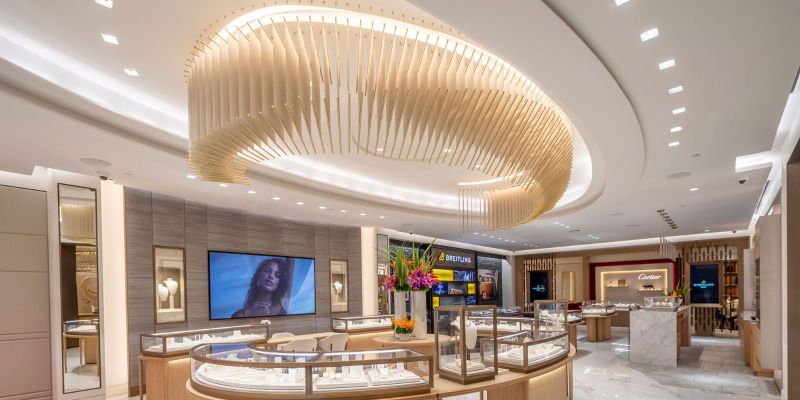27. March 2025
Restaurant Acoustics: How Interior Architecture Shapes the Dining Experience
Our Creation team visited the blox showroom, where they discovered innovative acoustics solutions for offices. Which got them thinking: What role can interior architecture play in improving restaurant acoustics?
Attentive service, delicious food and stylish interior design – these are all factors that add to a restaurant’s appeal. But an often underestimated factor plays a key role in whether guests feel at ease in a restaurant and want to return: the acoustics. Studies show that the acoustic stimuli of a restaurant have a direct impact on the well-being of the guests, the amount of time they spend there, and even on the way they taste the food.
The first thing that comes to mind when you hear «acoustic stimuli» is volume. But acoustics also encompass the quality of a soundscape, which includes speech intelligibility and echo. Then there is psychoacoustics, or the study of the subjective perception of acoustic signals. You probably perceive the lively din of background noise in a city pub differently versus in a Michelin-star restaurant.
Too loud and too quiet – both can be unpleasant
The significantly negative influence of high volume on the overall rating of a restaurant was shown in the field study by Wilczek, Steffens and Weinzierl (2020). The researchers studied the influence of volume and reverberation time on the perception and rating of restaurants. The relationship between these parameters and the pleasantness, liveliness and overall quality of the restaurant visit were analysed based on surveys of 161 restaurant guests and acoustic measurements taken in 13 Berlin restaurants.
Depending on the surroundings and guest expectations, overly muted noise levels can also be unpleasant. As a rule, nobody wants to feel like the people sitting at the table next to them can hear everything or to be distracted by the humming of an air conditioner.
Acoustic challenges in the restaurant industry
In heavily frequented spaces such as restaurants, dining rooms or hotel lobbies, there are numerous sources of sound: conversations, clattering crockery, scraping chairs, music and background noises. Hard surfaces such as glass, concrete or tiles intensify reflections and reverberation times, which makes it harder to have a relaxed conversation or cosy get-together.
Restaurant guests usually begin to speak louder when there is uncontrolled noise, which quickly builds up (the so-called Lombard effect). That is stressful and exhausting – both for guests and staff. In certain situations, guests spend less time in the restaurant and the unpleasant acoustics stick with them more than the culinary experience.
Factors for optimal restaurant acoustics
Well-planned acoustic design can be achieved through different measures that include both design-related and technological solutions – ones that are fine-tuned to the specific design and desired ambience. When you integrate acoustic design into your planning and material selection process, you have the opportunity to create a memorable dining experience that appeals to all the senses.
1. Acoustic materials:
- Sound-absorbing wall and ceiling panels made of wood, foam or textiles reduce noise and reverberations.
- Acoustic wallpaper is an interesting option; it is made of a special fleece and goes behind the actual wallpaper.
- Carpets minimise impact noise and help create a calmer atmosphere.
- High-quality acoustic curtains reduce reflections and contribute to noise reduction when installed correctly.
2. Modular acoustic solutions:
- Partition walls with sound-absorbing properties can be customised to meet different requirements.
- Acoustic ceiling sails can be discreetly integrated into the design and help direct the noise in a targeted way.
3. Technological solutions:
- Digital sound management systems analyse the soundscape in real time and dynamically adjust volumes or frequencies. They can automatically regulate the sound balance between background music and conversations in open areas.
- Smart speaker systems can project sound in specific areas without disturbing others.
- In very loud environments, active noise control (ANC) can help minimise unpleasant noises by creating an anti-noise (i.e. a noise that cancels out another). This works in a similar way to noise-cancelling headphones, but on a larger scale.
Acoustics are an essential component of interior design: not just in restaurants, but in all spaces where people spend time and talk to one another – whether in a hotel lobby, a bank or a pub. Getting professional support early on in a project and investing in this area pay off in the end – in the form of satisfied customers, positive reviews and a pleasant atmosphere that makes people want to go back.
Design memorable interiors with DOBAS Creation
Verena Zaugg
Interior Architect
Explore More Space Stories
Space Story #44 | 14 November 2024
From Vision to Reality: The Development of an Unusual Chandelier
Our team engineered a unique chandelier for Mayors Jewelers in Miami. In this post, interior architect Deborah Muff talks about the challenges that emerged in the process and our creative solutions to them.
Space Story #12 | 30 March 2021
The Search for the Perfect Veneer
In many of our projects, we use veneer. However, wood in the quality DOBAS requires is rare. Here, we explain how veneer is made and how we find suitable logs for our work.



